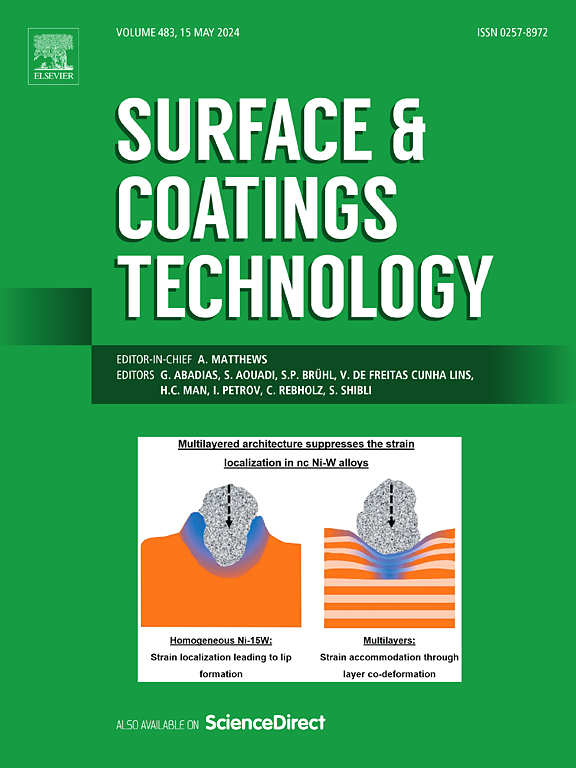AlCoCrFeNiZr高熵合金(HEA)涂层体系在1000℃和1100℃下的高温抗氧化性能评价
IF 5.3
2区 材料科学
Q1 MATERIALS SCIENCE, COATINGS & FILMS
引用次数: 0
摘要
采用粉末冶金的方法制备了高熵合金(HEA) AlCoCrFeNiZr粉末合金(每种元素1mol)。然后,利用HVOF和APS技术,将具有HEA性能的CoNiCrAlY和合成的AlCoCrFeNiZr沉积在Inconel 718上。为了检验其在暴露于高温下的航空航天部件中的适用性,将得到的AlCoCrFeNiZr-HEA涂层系统在1000°C和1100°C间隔5-100小时进行等温氧化测试。在测试之后,涂层系统在1100°C时瞬间变为具有74%原子占用率的方面体晶格。在此变化之后,没有破损或破碎,涂层系统的抗氧化性增加。在1000℃和1100℃氧化100 h后,TGO的厚度分别为2.124 μm±0.3和2.569 μm±0.3。本文章由计算机程序翻译,如有差异,请以英文原文为准。
Evaluation of high temperature oxidation resistance of AlCoCrFeNiZr high-entropy alloy (HEA) coating system at 1000 °C and 1100 °C
Powder metallurgy was used to create the high entropy alloy (HEA) AlCoCrFeNiZr powder alloy stoichiometrically (1 mol of each element). Then, using HVOF and APS techniques, CoNiCrAlY with HEA properties and the synthesized AlCoCrFeNiZr were deposited on Inconel 718. To examine its applicability in aerospace components exposed to high operating temperatures, the resulting AlCoCrFeNiZr-HEA coating system was put through isothermal oxidation tests at intervals of 1000 °C and 1100 °C and 5–100 h. Following the tests, the coating system momentarily changed to a rhombohedral lattice with 74 % atomic occupancy at 1100C. Following this change, there was no breakage or fragmentation and the coating system's resistance to oxidation increased. Furthermore, the TGO thickness was determined to be 2.124 μm ± 0.3 and 2.569 μm ± 0.3, respectively, following 100 h of oxidation at 1000 °C and 1100 °C temperatures.
求助全文
通过发布文献求助,成功后即可免费获取论文全文。
去求助
来源期刊

Surface & Coatings Technology
工程技术-材料科学:膜
CiteScore
10.00
自引率
11.10%
发文量
921
审稿时长
19 days
期刊介绍:
Surface and Coatings Technology is an international archival journal publishing scientific papers on significant developments in surface and interface engineering to modify and improve the surface properties of materials for protection in demanding contact conditions or aggressive environments, or for enhanced functional performance. Contributions range from original scientific articles concerned with fundamental and applied aspects of research or direct applications of metallic, inorganic, organic and composite coatings, to invited reviews of current technology in specific areas. Papers submitted to this journal are expected to be in line with the following aspects in processes, and properties/performance:
A. Processes: Physical and chemical vapour deposition techniques, thermal and plasma spraying, surface modification by directed energy techniques such as ion, electron and laser beams, thermo-chemical treatment, wet chemical and electrochemical processes such as plating, sol-gel coating, anodization, plasma electrolytic oxidation, etc., but excluding painting.
B. Properties/performance: friction performance, wear resistance (e.g., abrasion, erosion, fretting, etc), corrosion and oxidation resistance, thermal protection, diffusion resistance, hydrophilicity/hydrophobicity, and properties relevant to smart materials behaviour and enhanced multifunctional performance for environmental, energy and medical applications, but excluding device aspects.
 求助内容:
求助内容: 应助结果提醒方式:
应助结果提醒方式:


